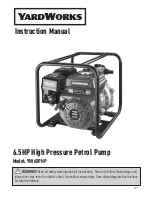
English
6
WILO SE 10/2021
• A 6" borehole is recommended for 4" pumps with
>9 m³/h rated volume flow rate, an 8" borehole is
recommended for 6" pumps with >30 m³/h rated
volume flow rate.
• The water inlet in a borehole or well must be ade-
quate for the pump's flow capacity.
• The pump is lowered into place using a block and
tackle and tripod, heavy pumps are lowered into
place using a cable winch. Installation should take
place away from the incoming water or the filter
pipe.
• Never allow the pump to run dry. It must be
ensured that, even during dry periods, the water
level never falls below the top of the unit.
• A consistent inner pipe diameter of 4" (102 mm)
or 6" (152 mm) should be ensured in order to
guarantee that the pump can be lowered easily.
• The pump must never be lowered or pulled up
using the electrical cable.
• Electrical connection work and extension of the
motor cable must be performed before lowering
the pump.
• The pump must be installed at least 0.30 m above
the bottom of the well or the borehole (Fig. 4).
• The system name plate must be fitted near the
borehole to ensure access to the technical data of
the installation.
• The insulation resistance on the motor and cable
must be checked prior to lowering (and during
lowering in deep boreholes) (min. 2 M
).
• Depending on pump design, the pump can be
connected via a solid or flexible pipe, 1¼" to 3"
nominal diameter.
• The pump must be secured using a safety rope
when using flexible pipes. Use the steel eye bolts
on the pump head for this (TWI4). If these attach-
ment points are not available (TWI6), an interme-
diate flange must be installed which has these
attachment points. Solid pipes are preferred.
• It is recommended that you fit an additional non-
return valve and shut-off valve on the borehole
output.
CAUTION! Danger of material damage!
When the water pressure is raised (>180 m Ws)
a non-return valve must be installed directly at
the pump outlet. The non-return valve must be
designed for a permissible operating pressure of
at least 20 bar!
• Observe the required motor cooling (see table
under "Fluid temperature")!
7.2 Electrical connection
DANGER! Risk of fatal injury!
A fatal shock may occur if the electrical connec-
tion is not made correctly.
Only allow the electrical connection to be made
by an electrician approved by the local electric-
ity supplier and in accordance with the local reg-
ulations in force.
• The current type and voltage of the mains con-
nection must correspond to the specifications on
the name plate.
• Use the connecting cable in accordance with
applicable standards/regulations and connect it
according to the switchgear or switch cabinet ter-
minal diagram.
CAUTION! Danger of material damage!
The max. length of the cable is dependent on the
nominal current consumption of the motor and
the cable cross-section!
Refer to the table and check the lengths and
diameters of the cable before connection!
Diameter and max. lengths of the cable for direct start:
Motor version
Motor
Cable
kW
4 x 1.5 mm²
4 x 2.5 mm²
4 x 4 mm²
4 x 6 mm²
4 x 10 mm²
4 x 16 mm²
EM
1~ 50/60 Hz 230 V
0.25
100
--
--
--
--
--
0.37
85
144
--
--
--
--
0.55
64
107
140
--
--
--
0.75
49
83
110
165
--
--
1.10
32
54
80
120
195
--
1.50
25
35
60
95
153
245
2.20
17
25
45
65
102
163
DM
3~ 50 Hz 400 V
3~ 60 Hz 480 V
0.37
661
1102
1764
2646
4411
7057
0.55
454
758
1213
1819
3032
4852
0.75
341
569
911
1367
2279
3647
1.10
245
409
655
983
1639
2623
1.50
179
299
478
718
1196
1915
2.20
121
202
324
486
811
1298
3.00
94
157
252
378
630
1008
3.70
76
128
204
307
512
819
4.00
70
118
188
283
472
755
5.50
52
87
140
210
351
562
7.50
39
65
104
157
261
418
Cable weight (kg/m)
0.20
0.25
0.30
0.40
0.65
0.85






























